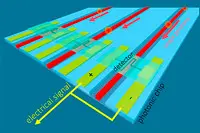Electronics News
Archive : 12 January 2015 год
 IBM received a record 7534 patents in 2014; the 22nd consecutive year it has topped the annual list of US patent recipients. During this time, it has amassed more than 81,500 US patents.
IBM received a record 7534 patents in 2014; the 22nd consecutive year it has topped the annual list of US patent recipients. During this time, it has amassed more than 81,500 US patents.
"IBM's continued investment in research and development is key to driving the transformation of our company, as we look to capture the emerging opportunities represented by cloud, big data and analytics, security, social and mobile," said IBM boss Ginni Rometty. "IBM's patent leadership over more than two decades demonstrates our enduring commitment to the kind of fundamental R&D that can solve the most daunting challenges facing our clients and the world."
On average, IBM won more than 20 patents per day in 2014 and became the first company to be awarded more than 7000 patents in a year. More than 3000 patents addressed cloud computing, analytics, mobile, social and security inventions. IBM also received more than 500 patents for inventions relating to cognitive systems.
The effort was contributed to by 8500 researchers in 43 countries, with operations outside of the US contributing to more than 34% of the 2014 patents.
Author
Graham Pitcher
Source: www.newelectronics.co.uk
 Research published in Engineering UK 2015; The State of Engineering claims the UK economy could benefit to the tune of £27billion a year if demand for new engineering jobs is filled. To do this, the organisation continues, the number of engineering apprentices and graduates entering the industry will need to double.
Research published in Engineering UK 2015; The State of Engineering claims the UK economy could benefit to the tune of £27billion a year if demand for new engineering jobs is filled. To do this, the organisation continues, the number of engineering apprentices and graduates entering the industry will need to double.
Paul Jackson, EngineeringUK's chief executive, said: "Engineering is a vital part of the UK economy, not just in terms of significant turnover but also with regards employment. For every new engineering role, an additional two jobs are created in the economy."
The report, produced by EngineeringUK, claims engineering companies will need 182,000 people per year with engineering skills in the decade to 2022, but points to a current annual shortfall of 55,000 skilled workers.
EngineeringUK is calling for collaborative action across government, engineering businesses, the education sector and the wider engineering community to realise a range of recommendations, including: a doubling of the number of engineering graduates or a 50% increase in the number of STEM and non STEM graduates entering engineering companies; a doubling of the number of young people studying GCSE physics as part of triple sciences; twice as many Advanced Apprenticeships; careers inspiration for all 11 to 14 year olds; and support for teachers and careers advisors delivering careers information.
Author
Graham Pitcher
Source: www.newelectronics.co.uk
 An array of light detectors developed by MIT researchers, in partnership with scientists from IBM and NASA's Jet Propulsion Laboratory, is said to be sensitive enough to register the arrival of individual photons and to have application in quantum computing.
An array of light detectors developed by MIT researchers, in partnership with scientists from IBM and NASA's Jet Propulsion Laboratory, is said to be sensitive enough to register the arrival of individual photons and to have application in quantum computing.
The sensors have been designed to be located on a silicon optical chip, but the team says such single photon detectors are temperamental. However, using standard manufacturing processes, the team has created denser and larger arrays, which are also more sensitive. In experiments, the researchers found their detector was up to 100 times more likely to detect a single photon than earlier arrays.
"Because one will want to make such optical processors with maybe tens or hundreds of photonic qubits, it becomes unwieldy to do this using traditional optical components," says Dirk Englund, an Assistant Professor in Electrical Engineering and Computer Science at MIT. "It's not only unwieldy, but probably impossible, because if you tried to build it on a large optical table, simply the random motion of the table would cause noise on these optical states. So there's been an effort to miniaturise these optical circuits onto photonic integrated circuits."
The process begins with a silicon optical chip made using conventional manufacturing techniques. On a separate silicon chip, they grow a thin, flexible film of silicon nitride, upon which they deposit the superconductor niobium nitride in a pattern useful for photon detection. Gold electrodes were deposited at both ends of the resulting detector.
A droplet of polydimethylsiloxane is attached to the silicon nitride film and a tungsten probe is pressed against it. The probe is used peel the film off its substrate and this is attached to the optical chip.
Whilst previous arrays detected only 0.2% of the single photons, the MIT team's chip reached 20%. However, a practical quantum circuit is likely to require an efficiency of 90% or more, says the team.
Author
Graham Pitcher
Source: www.newelectronics.co.uk
